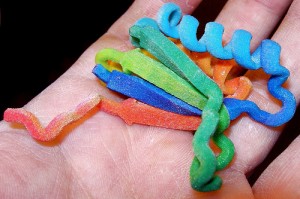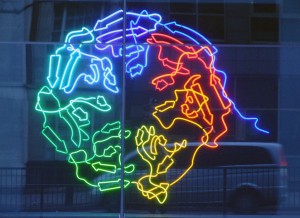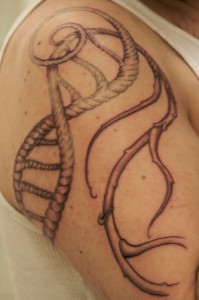On Molecular Viewers, or why I voted for RasMol
Nir London has recently started a poll asking “what is your favorite molecular viewer?” I voted for RasMol. As you can see from the results, I am in a low single-digit minority (4% when I am writing this). PyMOL (35%) VMD (27%) are leading. Why did I not vote for one of those? PyMOL is the de-facto standard for creating presentation movies and publication quality figures. It is also Python-scriptable, which is always a good thing. VMD is geared towards Molecular Dynamics analyses, but also produces great figures and has lots of nifty features. Both have their source-code made available under different licenses. PyMOL is dual licensed, with some features available on a paid basis; I’m cool with that.
If PyMOL and VMD are the Cadillac & Lexus of viewers, RasMol has to be the Vespa. It gets you there, but not in any kind of comfort, and there are lots of things it won’t do, missing two wheels and a roof; it gives you a bad image and bad hair when you ride it. It’s not even obviously cheaper: the vehicle analogy breaks with the price, since all three are free (as in beer and as in code). So why do I ride the Vespa when the Cadillac costs the same?
I only drive occasionally, and short distances at that.
The first answer is, that sometimes you want to do things very quickly, you have a relatively short distance to drive, and you don’t need the hassle of maneuvering a large car. I am a structural bioinfomatician. If I do heavy analyses, I do not do it through a viewer. Once I get to the heavy analysis stage, it means I have a lot of PDB files in some directory, and some code I am writing and re-writing to do some statistical analyses; these analyses are not fit for a molecular viewer. They are viewed via graphs, tables, histograms etc. They have mostly lost touch with the single molecule.
Sometimes I fire up RasMol just to see that whatever sites I mark are sane in terms of a single protein structure. The RasMol simple scripting language is great for that, and I actually find it easier to use than the PyMOL scripting, although I consider myself fluent in Python. This is not PyMOL’s fault: PyMOL is much stronger and rich in features than RasMol, but the flip side the learning curve for its language is obviously steeper. Since I only do it very occasionally, I always have to re-learn the syntax. A Cadillac needs more maintenace, detailing clean, and gas than a Vespa. Also, it can’t take that shortcut through the narrow dirt road.
Drawing is not viewing. Or: give ’em the old razzle-dazzle
Congratulations! You are writing up your results for a paper. Now you need some nifty molecular images. Now you need to draw a picture of a molecule, rather than just view it. Drawing a figure for a poster/publication/ talk is a whole different story. Do not use RasMol, even though it’s probably good enough for 95% of what you would like to publish, at least in static figures. Unfortunately, “good enough” does not cut it with most publications or seminars, at least those in which your publication or seminar will hopefully have some impact. Your figures need to look not only passable, or good, but great. This means that you need specularity, shading, plastic-metallo shiny surfaces, B-splines and all that jazz; all in >600dpi. Why?Because if you think your results are spectacular enough to publish in ________, then by some weird logic so should your pics. At least your editor & referees probably think so. There appears to be a bit of a Red Queen race in the molecular viewers as to razzle-dazzle factor: “what can we add the the Jones’s viewer does not have? I know! A backbone cartoon view with a specular metal granular matte surface on one side, and shiny smooth plastic on the other! Of course we need a control parameter for the plastic’s shininess and for the metal’s graininess”. The sad thing is, these pictures actually wow me. And papers that I read seem a lot nicer with impressive molecular models. I would like to believe that does not bias me as a referee, and when refereeing a manuscript I only take into account whether the figure conveys the information that the author wants it to convey. VDW-size mesh coverings around a ligand and extended stick images of catalytic residues in a ribbon backbone figures can help. Shading using a 45deg angle source of light can be impressive but does not contribute to the information in the figure. But yeah, they are cool and impressive; you should probably do that. Beware the temptation, however, to use the 45 and 120 degree angle pink and yellow light source, in combination with shiny plastic B-splines, which would make your protein model look like brothel decor. A picture is worth a thousand words. A two-thousand word picture is more like the yakkings of your alcoholic aunt at a family holiday dinner.
Went off on a tangent a bit up there. My point is: drawing is fine, overdrawing is not, and viewing is not drawing.Viewing is for seeing things for yourself, drawing is for showing other people. You need a lot less for the former than for the latter. Hence, RasMol still wins, hands down.
I’m a creature of habit
Ah, now we get to the real reason: I have been using RasMol forever, and I am so used to it, it would incense me to move to another piece of software. I’m fast & nimble with it. And yes, I am also a vim user. I’m hopeless with emacs. Now get off my lawn.
Comments are closed.






















